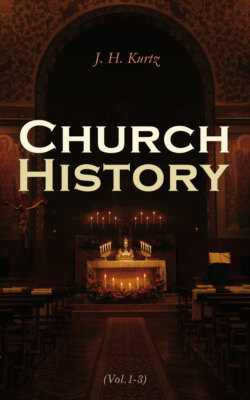Читать книгу Church History (Vol.1-3) - J. H. Kurtz - Страница 7
На сайте Литреса книга снята с продажи.
§ 3. Distribution of Church History according to Periods.
ОглавлениеIn the history of the world’s culture three historical stages of universal development succeed each other: the Oriental, the Franco-German, and the Teutono-Romanic. The kingdom of God had to enter each of these and have in each a distinctive character, so that as comprehensive a development as possible might be secured. The history of the preparation for Christianity in the history of the Israelitish theocracy moves along the lines of Oriental culture. The history of the beginnings of Christianity embraces the history of the founding of the church by Christ and His Apostles. These two together constitute Biblical history, which, as an independent branch of study receiving separate treatment, need be here treated merely in a brief, introductory manner. This holds true also of the history of pagan culture alongside of and subsequent to the founding of the church. Church history, strictly so-called, the development of the already founded church, begins therefore, according to our conception, with the Post-Apostolic Age, and from that point pursues its course in three principal divisions. The ancient church completes its task by thoroughly assimilating the elements contributed by the Græco-Roman forms of civilization. In the Teutono-Romanic Church of the middle ages the appropriation and amalgamation of ancient classical modes of thought with modern tendencies awakened by its immediate surroundings were carried out and completed. On the other hand, the development of church history since the Reformation has its impulse given it by that Teutono-Christian culture which had maturity and an independent form secured to it by the Reformation. This distribution in accordance with the various forms of civilization seems to us so essential, that we propose to borrow from it our principle for the arrangement of our church history.
The chronological distribution of the material may be represented in the following outline:
1 History of the Preparation for Christianity: Preparation for Redemption during the Hebraic-Oriental stage of civilization, and the construction alongside of it in the universalism of classical culture of forms that prepared the way for the coming salvation.
2 History of the Beginnings of Christianity: a sketch of the redemption by Christ and the founding of the Church through the preaching of it by the Apostles.
3 History of the Development of Christianity, on the basis of the sketch of the redemption given in the history of the Beginnings:In the Græco-Roman and Græco-Byzantine Period, under Ancient Classical Forms of Civilization.First Section, A.D. 70 to A.D. 323—down to the final victory of Christianity over the Græco-Roman paganism; the Post-Apostolic and Old Catholic Ages.Second Section, from A.D. 323 to A.D. 692—down to the final close of œcumenical development of doctrine in A.D. 680, and the appearance of what proved a lasting estrangement between the Eastern and the Western Churches in A.D. 692, which was soon followed by the alliance of the Papacy with the Frankish instead of the Byzantine empire; the Œcumenico-Catholic Church, or the Church of the Roman-Byzantine Empire.Third Section, from A.D. 692 to A.D. 1453—down to the overthrow of Constantinople. Languishing and decay of the old church life in the Byzantine Empire; complete breach and futile attempts at union between East and West. The Church of the Byzantine Empire.In the Mediæval Period, under Teutono-Romanic Forms of Civilization.First Section, 4–9th cent.—from the first beginnings of Teutonic church life down to the end of the Carlovingian Age, A.D. 911. The Teutonic Age.Second Section, 10–13th cent.—down to Boniface VIII., A.D. 1294; rise of mediæval institutions—the Papacy, Monasticism, Scholasticism; Germany in the foreground of the ecclesiastico-political movement.Third Section, the 14–15th cent.—down to the Reformation in A.D. 1517; deterioration and collapse of mediæval institutions; France in the foreground of the ecclesiastico-political movement.In the Modern Period, under the European Forms of Civilization.First Section, the 16th cent. Age of Evangelical-Protestant Reformation and Roman Catholic Counter-Reformation.Second Section, the 17th cent. Age of Orthodoxy on the Protestant side and continued endeavours after restoration on the side of Catholicism.Third Section, the 18th cent. Age of advancing Illuminism in both churches—Deism, Naturalism, Rationalism.Fourth Section, the 19th cent. Age of re-awakened Christian and Ecclesiastical life. Unionism, Confessionalism, and Liberalism in conflict with one another on the Protestant side; the revival of Ultramontanism in conflict with the civil power on the Catholic side. In opposition to both churches, widespread pantheistic, materialistic, and communistic tendencies.
